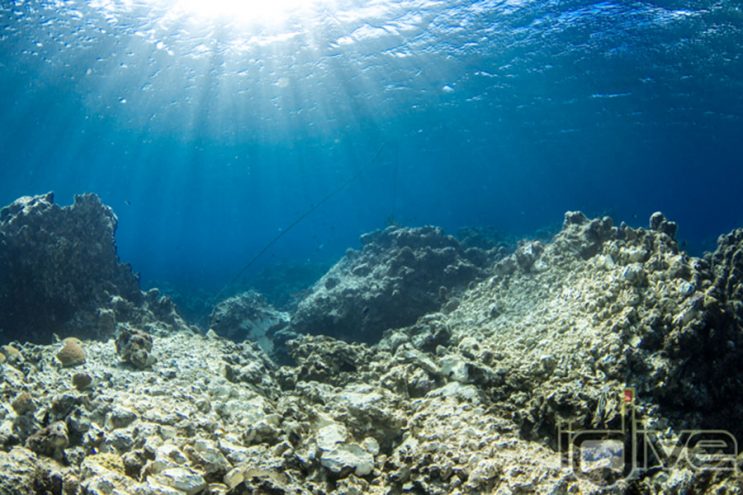Tradegy Repeats Itself
Living on a tropical island in the Caribbean should be what dreams are made of, unfortunately however, recent events in Grand Cayman are more comparable to a recurring nightmare. Last week, islanders were once again subjected to the site of history repeating itself, the result being the mass destruction of thousands of square feet of vital coral reef. This latest disaster occurred when the Russian cargo ship “Saga” attempted to leave Georgetown dock but somehow managed to miscalculate the environment and ended up running aground on the reef. The destruction, which has so far been under-estimated, includes the collapse of a swim through on the world famous Eden Rock dive site and the crushing and displacement of huge chunks of surrounding coral.
The current situation is that the captain and crew of the 328 foot ship have remained in Georgetown and are in discussions with the Department of Environment (DoE) about the incident. Outside, fingers of blame are already being pointed in different directions. Many are wondering why it is not necessary for vessels like the Saga to have a pilot ship with a local captain to guide them safely in and out of the dock, a practice that is mandatory elsewhere in the world. Meanwhile, below the surface of the nearby water, a section of perhaps one of the most photographed reefs in the Cayman Islands lies in ruin. This is by no means the first time that Grand Cayman’s precious underwater paradise has been damaged by a heavy vessel. We seem to be experiencing a paralysis of repetition where one significant act of destruction sets the clock ticking, the next never far behind.
Two and a half years ago, 16,000 square feet of coral was destroyed by the Carnival Magic cruise ship. In this case, blame was never fully assigned and therefore no single body was held accountable for the damage. Due to the lack of ownership of the catastrophe that occurred near Don Fosters dive centre, the efforts that were made to recover the reef were carried out by a concerned collection of local residents and businesses. Almost a year after the crushing blow was dealt, Carnival donated $100,000 to the recovery project while accepting no responsibility for the accident itself. More recently, Microsoft founder Paul Allen had paid a so far undisclosed amount of money to the Cayman Islands following an incident when the anchor from his luxury yacht Tatoosh had been positioned badly. Mr Allen funded a professional recovery operation while accepting no blame for the accident, he also contended the government’s claim that 14,000 square feet of coral had been damaged in the incident.

So it seems that in our vicious circle of repetition the general format is for disaster to strike and then be followed up with a handsome payment for a coral regeneration project. In each of the cases above, I wouldn’t want to undermine the efforts of those involved with the recovery projects but realistically, what condition are the reefs left in after the reparation attempts have finished? They are certainly not as good as new. A short swim around the area hit by the Saga will reveal entire coral structures cracked in two, collapsed swim-through structures and brain coral that has taken centuries to grow just smashed into bits and lost forever. In short, much of the damage done in these cases is irreparable and no matter how much money is donated or fined, the reef will not bounce back.
With that in mind, surely it has to be agreed the prevention is better than cure. We need to break the paralysis of repetition and utilize practices that put environmental conservation as a higher priority. In particular, with all the stressors that are steadily chipping away at the health of our reefs, we need to do whatever we can to protect every piece of coral that is left. The importance of the world’s coral reef systems simply can’t be undermined and the day to day threats that face them like climate change, over fishing, acidification, pollution, dynamite fishing and so on have to be addressed with a serious view of giving the oceans a chance to recuperate a little.
Unfortunately, news from this little corner of the world does not get any better as the Island has just recently approved plans to build a new cruise ship port in Georgetown. The three year project will see vast development as the new port is constructed on top of the existing reef, underwater habitats for miles around will in turn be destroyed by the silt caused by the dredging work. With this in mind, it seems as though these efforts that we need to make to protect and conserve the ocean are not yet within our reach. Perhaps more accurately, they are not yet financially viable in comparison to the profit margins of the big players who work the waters of the Cayman Islands.
It amazes me how far we can let things go before people start to take notice. The writing is on the wall, our oceans are dying and this recent activity is yet another nail in the coffin. Widespread destruction and the multi-pronged attacking of the ocean, far outweighs any environmentally minded efforts to conserve our life preserving resources. Without any positive change in sight, my advice to you is when you are out diving, take as many pictures as you can of the underwater world while it is still alive as if we carry on at this rate, very soon pictures will be all we have left.
The video below was shot on Tuesday November 29th, less than one week after the Saga ran aground atop Eden Rock.
Eden Rock from iDive Global on Vimeo.
About the Author: Drew McArthur is a professional dive instructor and boat captain currently working at Divetech on Grand Cayman. Since his first dive over 20 years ago, he has found himself in all kinds of underwater environments from golf ponds on the side of a snowy Welsh mountain to the tropical paradise he has now become accustomed to. A fanatic of all things tech, one of the main things Drew loves about Grand Cayman is the accessibility of such premier dive sites. Check out Drew’s blog here.
Explore the Dive Sites of the Cayman Islands with iDive!

